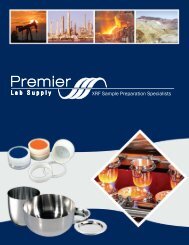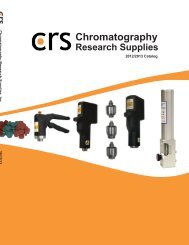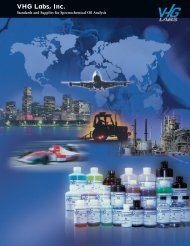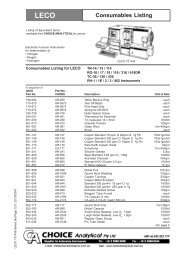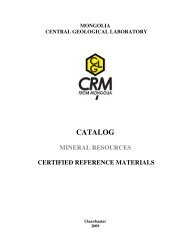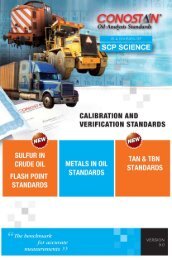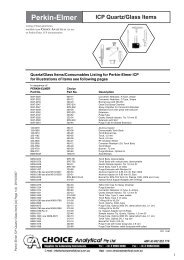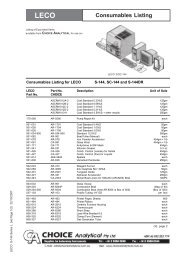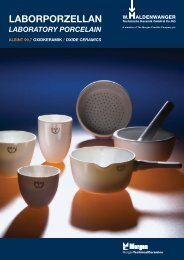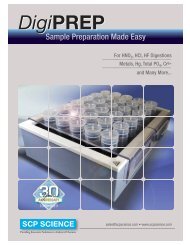You also want an ePaper? Increase the reach of your titles
YUMPU automatically turns print PDFs into web optimized ePapers that Google loves.
HPLC ColumnsSelf-Assembled Monolayers(SAM) in Separation ScienceSelf-Assembled Monolayers (SAM) aresupramolecular organizates resembling, insome respects, the well-known Langmuir-Blodgett (LB) built-up films while displayingother distinct and rather unique features.Much of the interest in SAM stems from theirpotential in a wide range of scientific andtechnological applications. The first applicationof SAM in chromatographic separation sciencewas developed at the University of Delawareby Fatunmbi and Wirth.The bonding technique allows orderedmonolayers of functional molecules to bechemically immobilized on solid substrates,such as silica and alumina. The technique ofbonding was termed “horizontal polymerization”due to the fact that there is significant Si-O-Sibridging parallel to the silica substrate. This isachieved by reaction of trifunctional silanizingagent with the silica substrate under anhydrouscondition, except for a monolayer of wateron silica. This contrasts with conventionalpolymerization of trifunctional silanes, referredto as “vertical polymerization,” where wateris deliberately added to polymerize thereagents before attachment to the surface.The key structural difference is that horizontalpolymerization provides much higher liganddensity at the silica surface boundary.HPLC Columns<strong>Analtech</strong> is proud to offer, for the first time, High Pressure Liquid ChromatographyColumns. <strong>Analtech</strong> is partnering with Separation Methods Technologies - anothercompany committed to excellence in chromatography.Separation Methods Technologies (SMT) utilizes proprietary bondingtechnologies that result in bonded phase coverages that approach 100%. SMT’smethods of bonding allow the density of the functional ligands to be controlledwith appropriate spacer molecules, a novel procedure that ensures TOTALCOVERAGE and highly cross-linked polysiloxane under layer structure. Theresults are bonded phases that are well protected and that show unprecedentedresistance to both acid and base hydrolysis. Self-Assemled Monolayers (SAM)technology provides you with the widest range of column retention selectivitiesand performance benefits.HPLC Method Development - Choosing a columnThe column of choice for analytical methods development is very easy; the bestcolumn for an application is the column that gives the highest performance underthe most favorable condition desired by the end-user. Most analytes are acidic,basic or neutral. The best initial approach is to use a mid-range pH, such as pH7. The standard SMT SAM-C18 and C8 columns are the best choice for use atthis pH because they provide superior column lifetime, extremely high selectivityand resolution. Acetonitrile or methanol and water are normally the first choice formobile phase.Another option is combination of organic solvent with phosphate buffer (withbuffer range pH 6.2-8.2) or acetate buffer (with buffer range pH 3.8-5.8). Methoddevelopment optimization can continue from here by changing several factors,including mobile phase, pH, column temperature (up to 95 degrees C). SMTSAM-C18 is uniquely stable to high temperatures, a characteristic that can beused as an additional tool to improve resolution.Using a low pH mobile phase results in the best peak shapes for basiccompounds because these analytes are fully protonated and exhibit low retentionand tailing. SMT SAM C18 or C8 columns are the best choice providing longestavailable lifetime and performance at low pH.Separations at high pH region may also be the most appropriate for certaincompounds. For example, it may be possible to separate bases in their freeform – where they are not charged. Here the retention increases as the chanceof obtaining the desired selectivity improves. SMT SAMC18 column has highestligand density available and offers the best protection (up to pH 12) of the silicasubstrate from being dissolved by the strongly basic mobile phase.48PHONE: 800.441.7540 • 302.737.6960 FAX: 302.737.7115WWW.ANALTECH.COM



